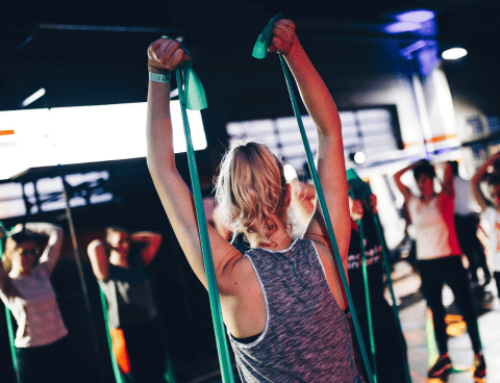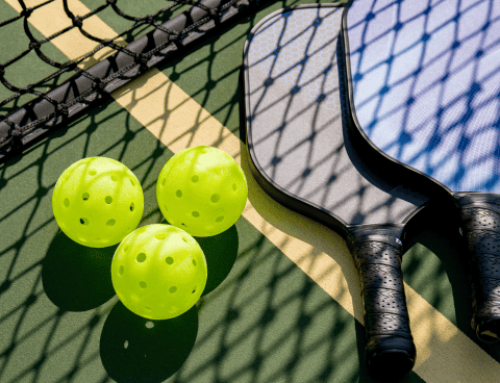9 Unique Ways You Can Use a Foam Roller to Become a Better Athlete
A foam roller has an extremely boring job.
It usually lays somewhere in the corner of a fitness facility or weight room, waiting for you to pick it up, roll your muscles, and then put it right back. Maybe you even have this piece of equipment laying somewhere around your house, and if so, it’s most likely gathering dust.
Although the foam roller might seem like a one-trick pony that can’t be used for anything more than a quick roll out of your muscles, you can actually use it to add some extra challenge to your existing training routine. All it takes is a little creativity.
With that in mind, I’d like to show you nine unconventional ways you can use a foam roller to enhance the effectiveness of both your warm-ups and your strength workouts.
1. All-Fours Belly Breathing
Suggested Sets/Reps: 1×5 breaths at the beginning of your warm-up
By itself, this exercise is a wonderful warm-up tool for people who live in extension. This often applies to baseball players, who frequently live in a state of extension where their lower backs are constantly arched and their chests are constantly puffed up like Superman.
In a regular all-four belly breathing exercise, you get down on all fours, tuck your pelvis underneath you (which is the opposite of extension), push the floor away from you with your upper body (creating a dome with your mid back), and slowly breathe in and out. Each time you breathe out, you push the floor farther away.
When you perform this exercise, you’ll feel your abs, your serratus and your glute muscles working. But when you add a foam roller to the equation and place it underneath your hands, the exercise is taken to another level of effectiveness. I don’t think I ever felt my abs working so hard as they did the first time I tried this move with a foam roller.
2. Windmill Stretch
Suggested Sets/Reps: 1×6-8/side
For the athletes I train, this is definitely their favorite exercise. When you give it a shot, odds are you’ll love it, too—likely for a couple different reasons.
For one, the Windmill Stretch combats the tightness in your chest that comes from sitting at a laptop or desk for hours on end. It also helps improve the mobility of your spine which is likely limited due to those same prolonged hours of hunching over in a seated position. Finally, it helps to stretch some of your rear muscles, particularly your glute medius.
3. Serratus Wall Slides
Suggested Sets/Reps: 2×8 reps
After spending three months learning about shoulder health from Eric Cressey and his crew during my internship at Cressey Sports Performance, Serratus Wall Slides became one of my go-to exercises to help clients keep their shoulders in good condition.
Serratus Wall Slides are a great exercise to help with activation of the serratus muscle. The serratus is a muscle that’s essential to healthy shoulder movement. It aids in reaching above your head, or pushing people away from you, or performing perfect Push-Ups and Pull-Ups, or bench pressing a good amount of weight.
I like to include this exercises both during the warm-up and between bench sets for my clients. Now that you are all warmed up and ready to go, here are a few ways to incorporate a foam roller in your strength training.
4. Push-Ups
Suggested Sets/Reps: 3×8 reps
During January, I did a challenge. Every day for 30 days (I started on the 2nd), I did 10 Push-Ups every morning. Why? Because my coach told me that if I wanted to finally break my Bench Press plateau, I had to stop whining and start doing Push-Ups. God knows how much I hate these. But because I wanted to break my bench plateau so badly, I decided to give it a try.
How did I feel after I completed the challenge? Like I never wanted to do Push-Ups again. Ever.
However, a Push-Up is a great exercise for whole-body strength, especially when you have no other tools around other than your body. To make them a little bit more advanced, try adding some instability. The foam roller is a perfect tool for this. Just place your hands on a foam roller, and perform a few rounds of Push-Ups.
Why is it a good variation? It makes your core work harder, for one. But it also challenges the muscles of your rotator cuff to work on stabilizing your humerus bone, thus making this variation a great one for your shoulder health and strength.
5. Planks
Suggested Sets/Reps: 3x10breaths
If you are looking for a way to spice up the boring old Plank, try holding a Plank on a foam roller. I suggest focusing on the number of breaths you take when holding a Plank as opposed to a number of seconds. Pro tip: If this variation is also easy for you, try to move foam roller back and forth a little bit during your Plank. Your core will thank you later.
6. Ab Rollouts
Suggested Sets/Reps: 3×6-8
If you think regular Ab Rollouts aren’t hard enough, let me introduce you to Ab Rollouts on a foam roller. Before you proceed, however, I’d like to mention this is an advanced move. If you’re just getting started, you should first work to master the standard Ab Rollout. You could start learning the move on a Swiss ball on your knees, then move to the ab wheel, and then you could try it with the foam roller.
But if you’ve mastered all these versions already and would like to take the exercise to a whole new level, give Ab Rollouts with a foam roller a try. This one might be a bit tricky. As you can see in the video, I start by walking the roller out and then switch to my forearms.
7. Hamstring Curls
Suggested Sets/Reps: 3×8-10 (or whatever you can handle)
Sure, there are loads of ways to make a Hamstring Curl harder. You can take a smaller Swiss ball, or use a heavier med ball, or do a Single-Leg Curl, or even do it with Valslides. But nothing, and I repeat NOTHING, takes your hammie gains to the next level like using a foam roller does.
Painful? Yes.
Worth trying? Absolutely. It’s a great variation when other ones feel easy or you find yourself short on equipment.
The setup is simple here: You place your feet on a foam roller and roll it out as far as you can, then bring it close to your bum.
8. Single-Leg Glute Bridge
Suggested Sets/Reps: 3×12
To continue with hamstring gains, this is a money-maker move right here. When I tried this variation for the first time, I had never felt my hamstrings work so hard—not even during a 330-pound Deadlift. I’d like to speculate that the instability of the foam roller is what makes it so much more challenging.
9. Single-Leg Deadlifts
Suggested Sets/Reps: 3×8/s
This is one of my favorite variations for teaching SLDLs. Why?
Usually, when people think of tipping over on one leg, they flare their hips to the side, like in a yoga pose. But in a Single-Leg Deadlift, you want to keep your hips squared to minimize risk of a lower-back injury and maximize the activation of your gluteus medius muscles. In other words, you want your butt and hammies to do the work, not your back.
To help you achieve the perfect alignment of the pelvis, I like to use the foam roller. You will place the foam roller on top of the foot of the leg that is about to be pushed back. This will insure that you are hinging properly through the hips and keep your hips squared.
READ MORE:
RECOMMENDED FOR YOU
MOST POPULAR
9 Unique Ways You Can Use a Foam Roller to Become a Better Athlete
A foam roller has an extremely boring job.
It usually lays somewhere in the corner of a fitness facility or weight room, waiting for you to pick it up, roll your muscles, and then put it right back. Maybe you even have this piece of equipment laying somewhere around your house, and if so, it’s most likely gathering dust.
Although the foam roller might seem like a one-trick pony that can’t be used for anything more than a quick roll out of your muscles, you can actually use it to add some extra challenge to your existing training routine. All it takes is a little creativity.
With that in mind, I’d like to show you nine unconventional ways you can use a foam roller to enhance the effectiveness of both your warm-ups and your strength workouts.
1. All-Fours Belly Breathing
Suggested Sets/Reps: 1×5 breaths at the beginning of your warm-up
By itself, this exercise is a wonderful warm-up tool for people who live in extension. This often applies to baseball players, who frequently live in a state of extension where their lower backs are constantly arched and their chests are constantly puffed up like Superman.
In a regular all-four belly breathing exercise, you get down on all fours, tuck your pelvis underneath you (which is the opposite of extension), push the floor away from you with your upper body (creating a dome with your mid back), and slowly breathe in and out. Each time you breathe out, you push the floor farther away.
When you perform this exercise, you’ll feel your abs, your serratus and your glute muscles working. But when you add a foam roller to the equation and place it underneath your hands, the exercise is taken to another level of effectiveness. I don’t think I ever felt my abs working so hard as they did the first time I tried this move with a foam roller.
2. Windmill Stretch
Suggested Sets/Reps: 1×6-8/side
For the athletes I train, this is definitely their favorite exercise. When you give it a shot, odds are you’ll love it, too—likely for a couple different reasons.
For one, the Windmill Stretch combats the tightness in your chest that comes from sitting at a laptop or desk for hours on end. It also helps improve the mobility of your spine which is likely limited due to those same prolonged hours of hunching over in a seated position. Finally, it helps to stretch some of your rear muscles, particularly your glute medius.
3. Serratus Wall Slides
Suggested Sets/Reps: 2×8 reps
After spending three months learning about shoulder health from Eric Cressey and his crew during my internship at Cressey Sports Performance, Serratus Wall Slides became one of my go-to exercises to help clients keep their shoulders in good condition.
Serratus Wall Slides are a great exercise to help with activation of the serratus muscle. The serratus is a muscle that’s essential to healthy shoulder movement. It aids in reaching above your head, or pushing people away from you, or performing perfect Push-Ups and Pull-Ups, or bench pressing a good amount of weight.
I like to include this exercises both during the warm-up and between bench sets for my clients. Now that you are all warmed up and ready to go, here are a few ways to incorporate a foam roller in your strength training.
4. Push-Ups
Suggested Sets/Reps: 3×8 reps
During January, I did a challenge. Every day for 30 days (I started on the 2nd), I did 10 Push-Ups every morning. Why? Because my coach told me that if I wanted to finally break my Bench Press plateau, I had to stop whining and start doing Push-Ups. God knows how much I hate these. But because I wanted to break my bench plateau so badly, I decided to give it a try.
How did I feel after I completed the challenge? Like I never wanted to do Push-Ups again. Ever.
However, a Push-Up is a great exercise for whole-body strength, especially when you have no other tools around other than your body. To make them a little bit more advanced, try adding some instability. The foam roller is a perfect tool for this. Just place your hands on a foam roller, and perform a few rounds of Push-Ups.
Why is it a good variation? It makes your core work harder, for one. But it also challenges the muscles of your rotator cuff to work on stabilizing your humerus bone, thus making this variation a great one for your shoulder health and strength.
5. Planks
Suggested Sets/Reps: 3x10breaths
If you are looking for a way to spice up the boring old Plank, try holding a Plank on a foam roller. I suggest focusing on the number of breaths you take when holding a Plank as opposed to a number of seconds. Pro tip: If this variation is also easy for you, try to move foam roller back and forth a little bit during your Plank. Your core will thank you later.
6. Ab Rollouts
Suggested Sets/Reps: 3×6-8
If you think regular Ab Rollouts aren’t hard enough, let me introduce you to Ab Rollouts on a foam roller. Before you proceed, however, I’d like to mention this is an advanced move. If you’re just getting started, you should first work to master the standard Ab Rollout. You could start learning the move on a Swiss ball on your knees, then move to the ab wheel, and then you could try it with the foam roller.
But if you’ve mastered all these versions already and would like to take the exercise to a whole new level, give Ab Rollouts with a foam roller a try. This one might be a bit tricky. As you can see in the video, I start by walking the roller out and then switch to my forearms.
7. Hamstring Curls
Suggested Sets/Reps: 3×8-10 (or whatever you can handle)
Sure, there are loads of ways to make a Hamstring Curl harder. You can take a smaller Swiss ball, or use a heavier med ball, or do a Single-Leg Curl, or even do it with Valslides. But nothing, and I repeat NOTHING, takes your hammie gains to the next level like using a foam roller does.
Painful? Yes.
Worth trying? Absolutely. It’s a great variation when other ones feel easy or you find yourself short on equipment.
The setup is simple here: You place your feet on a foam roller and roll it out as far as you can, then bring it close to your bum.
8. Single-Leg Glute Bridge
Suggested Sets/Reps: 3×12
To continue with hamstring gains, this is a money-maker move right here. When I tried this variation for the first time, I had never felt my hamstrings work so hard—not even during a 330-pound Deadlift. I’d like to speculate that the instability of the foam roller is what makes it so much more challenging.
9. Single-Leg Deadlifts
Suggested Sets/Reps: 3×8/s
This is one of my favorite variations for teaching SLDLs. Why?
Usually, when people think of tipping over on one leg, they flare their hips to the side, like in a yoga pose. But in a Single-Leg Deadlift, you want to keep your hips squared to minimize risk of a lower-back injury and maximize the activation of your gluteus medius muscles. In other words, you want your butt and hammies to do the work, not your back.
To help you achieve the perfect alignment of the pelvis, I like to use the foam roller. You will place the foam roller on top of the foot of the leg that is about to be pushed back. This will insure that you are hinging properly through the hips and keep your hips squared.
READ MORE:











